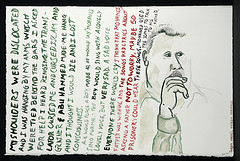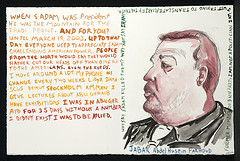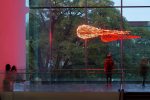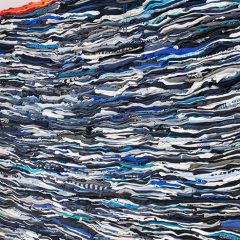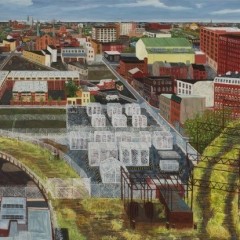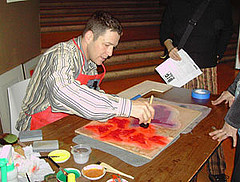
Daniel Heyman, a master printmaker, working at last year’s Big Block printing event at the Philadelphia Museum of Art
I met Daniel Heyman June 23 at the Last Drop coffee shop then we walked to the Doubletree Hotel where there was space for him to lay out his large prints on the floor in the lobby and show me. The artist’s level of commitment to the project is very high. Heyman, a boyish 40-something has always had a political streak in his art. Our mutual friend, Ann Northrup, pointed out to me that Daniel had made a piece about the gang beating death of Eddie Polec in 1994. Daniel’s diary about Amman trip, which is on his website, is a great read. The artist expresses his dismay, fear, sympathy and outrage in prose that’s right from the heart. And see previous post for more.
How did you get involved with the Amman project?
Susan Burke of Burke Pyle LLC-you have to talk to her. She’s the head lawyer on the case, the class action lawsuit… The court case is against the private companies helping to run the prisons. that’s because of where you could try to case. If you sue the American government then it’s a World Court case. This way, against these contractors–Wall Street-traded companies-it can be tried in the US. courts. Rumsfeld is listed on the suit but the suit’s against the contractors.
How do you know her?
I know her through Brian Wallace (former Director of Exhibitions, Galleries at Moore College). Brian and his wife are friends of Susan’s and he introduced us over dinner at their house. We’re having dinner and then – out of the blue – Susan says “Want to come with us (to Amman)? I never expected that. She said they go 3 or 4 times a year. She brings artists, documentary photographers, video people etc.
I really want to go back again with them…It’s supposed to happen. It was supposed to happen 3 weeks ago but that trip was postponed. The Americans always wait until the Iraqis get to Amman and then they go over. The Iraqis couldn’t get exit visas. This was right before Mousaui was killed. Maybe all of them who’ve been in touch with Susan and the lawyers have been black-listed?…anybody whos on the list as having contacted susan’s organization?
How long were you there?
I was there 7 days. I was with the lawyers in one interview then the lawyers said “No more.” (because the legal questions were very technical) so we did our own.
So how did you do your drawings?
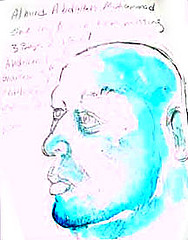
Watercolor drawing of one of the Iraqi victims, the one-arm, one-leg man.
I went with 8 copper plates and I started drawing and transcribing [words]. I had to decide when is it gonna be good– should I wait or should these words be it? I finished the 8 copper plates in 3 days. Then I did watercolors. (you can’t get copper plates in Amman). I carried them on the plane. I was worried they’d be confiscated. I sat next to Ramsey Clark on the plane. We were talking. He was talking to me about Saddam Hussein’s trial. He thinks everybody deserves a fair trial. He doesn’t want him executed […until all the war crimes against him have been tried.]
I got off the plane and I asked someone remind me again who’s Ramsay Clark-I know he was Attorney General under Johnson… and they said he’s one of Saddam Hussein’s lawyers.
Chris Bartlett was the photographer. He set up a portrait studio and shot photos separately.
Tara McKelvey is the journalist. (She’s with the American Prospect and working on a book and an article about this)
Who paid for your trip?
I paid for it. Susan said it costs $2,000. I said that’s a lot of money. She said why don’t I buy a painting and that’ll help.
Tell me about the people
They were all terrified they’d be killed. Actually one was killed two weeks after I got back.
You mean they went back to Iraq after being out in Jordan?
They had families back there. One woman around 50 years old. She had 5 kids. She was very well educated. She had asked her husband for a divorce. Her husband said ok but you don’t get so see any of the children; you get no money; you must leave the house. Then she dyed her hair. And somebody turned her in because of the dyed hair. She must be a terrorist…she dyed her hair.
You said they were all Sunnis?
Everybody we interviewed was Sunni. The Shiites turned her in because she dyed her hair. She must be a terrorist, right? You feel the terror. The soldiers are terrified. The people are terrified.
When the war happened, nobody’s for war…So the woman who dyed her hair, she and another woman on her street made dinner for the soldiers. Kebabs. (The recipe is on my website) Then her son was arrested. She was really scared….Now she hates Americans. She’s really scared for her son (he’s still in prison). She went back.
Here’s another story. A man sees two of his sons killed before his eyes. He wants the world to know they were very smart boys.
Tell me about the one-arm, one-leg man
It’s so complicated. It’s so not black and white. His story was really moving. It made me see that to survive sometimes you have to create a narrative of your life that makes you the hero…that helps you make sense of what happens. He was walking in the street and a bomb went off. His arm is off and his leg was injured. And he was arrested and brought to the hospital. He said the soldiers came in and said to the doctors, you can’t fix his arm.
I wasn’t really sure that any of this was factual because he was probably in a lot of shock.
After the hospital he was in Abu Ghraib. He said he was left in the sun and washed in dirty water and his wounds got infected and they had to amputate.
You have to believe you’re not just the recipient of bad luck. Nobody can live with that. But it doesn’t make sense that an American medic would infect him on purpose. He was in the hospital when prisoners would come in who had been in Disco Mosul. Everybody’s heard of this but nobody could verify its existence.
What’s Disco Mosul?
It’s where they take the most religious prisoners and make them dance disco until they drop. And then they beat them and send them to the infirmary. [The man with one arm and leg – because he was in the infirmary – saw Iraqis who had been tortured in Disco Mosul.]
You said there were children in the prison?
There was an entire children’s section. There was a story. All the prisoners were in cells and nobody could see anybody else (they hooded them when they moved them about the prison). But they heard a lot. The translators for the soldiers were taunting one kid to “sing for us”:. And the kid would sing. And his father was in the same prison but couldn’t see his son.
You’re going to the NY Public Library today to show the prints? That would be a great place for these. Other plans…a book?
I’m bringing them up there to show Roberta Waddell, the head curator of prints and drawings. Maybe it’ll be a book. Tara the journalist is working on a book… I showed them to Bob Brand and he’s enthusiastic. I’m on the board of Philagrafica. We made an edition of 30 (with Cindy Ettinger of C.R. Ettinger Studio). I wrote in English backwards while it was spoken. First I did a watercolor then the copper plate.
I want to do the text in arabic in the background….
Tell me about Our eyes were covered.
I didn’t have time to check spelling. Every once in a while there’s a cross out.
But they’re all out of prison now?
None were ever accused and all were released.
One 16 year old, a nephew of the man whose sons were killed. He was in the part of the prison for children. He said you could hear the dogs and feel their breath (they were hooded).
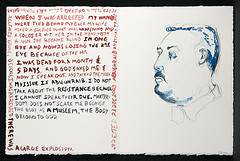
Watercolor drawing by Daniel Heyman
This one…”From here the tragedy started” He was tortured for 30 days. We saw him 2 times and we still didn’t get through the 30 days of torture. He did nothing really but he was a Sunni and he had been in the party and was turned in.
It’s so stupid.
They were all incredibly dignified. They’re religious people.
How do they get out of Iraq?
The law firm pays transportation and hotel. [It’s a very long journey by car or taxi and sometimes they don’t make it through customs at the border]
How would you work, drawing first, then words?
I’d go back and forth with the drawings and words.
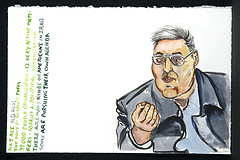
This man is an Iraqi activist on behalf of the torture victims
What did the Iraqis want ultimately?
Their idea of reparations is kind of small.
Tell me about Jasim, Kahaydher Abbas
This is the man who was killed. He was the most dignified person I saw. He was incredible. Tall, elegant, handsome. He was in a metal cage for 10 days. They forced him to hit his son. Then they forced his son to hit him. I don’t know why he was killed but two weeks after we saw him he was killed…by an unknown gunman. He was a farmer. I asked him how long was the farm in your family? He said 15-16 generations!
Tell me about the watercolors
This story is about Ramadan. He ran a store. His 2 kids were killed. Immediately the soldiers came and the helicopters were overhead…He said I picked up my son and held him above my head. (He was wearing a kaftan-it very biblical-imagine it). One son’s head was blown off and he didn’t realize it (he was in shock) The soldiers were threatening him but then they got some order from the helicopter and backed off. They went out into the nearby field and picked up his son’s head and brought it back. He wouldn’t let me draw him so I drew the translator. This is the one that got me. That was the absolute worst. He was terrified. He didn’t give me his name.
Tell about the translators
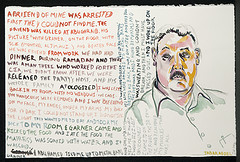
Watercolor, Heyman
The translators were Iraqis. They didn’t know what to expect.
Haj ali al Quusi
His hand is crippled. He is really smart, nice. Very smart. He started an organization in Bagdad to help victims. He’s like a liaison. He was one of the people under the blanket in the Abu Ghraib picture standing on the box with the wired attached to his fingers. There were two photos-one with a thin man that most everybody has seen, another with a big man. Haj was the big man under the blanket.
Where did the interviews take place?
In the hotel rooms. Sometimes ours, sometimes theirs. At one point, we saw through the window that some shepherds were moving a herd of goats to a field nearby… That was unreal.
So did you work at a desk or sit on the floor?
With the copper plates I worked on my lap, sometimes on the floor; sometimes in a chair.; with the watercolors I’d use the coffee table.
Then what?
We would have dinner together. We were all in the same hotel. But we couldn’t talk with them…The translators were gone.
Did you pick up any arabic at all?
In shala…with the will of allah…
Tell me about your book again
The watercolors will be turning into a book with woodblocks for the words. 4 pages. I’m in the middle of carving the blocks. Each one will be 7-8 blocks. Look at Francesco Clemente. He uses woodblocks and it looks like watercolor. That’s what I want. I found out Japanese woodblock printers were using methyl cellulose for woodblock printing and it’s much better.
What do you mean?
Japanese printing is all water-based. You mix a glue into the ink, usually a rice paste (so it doesn’t run). but now I’m using methyl cellulose (wallpaper paste)
What’s up this fall?
I’m teaching two days at Tyler; one day at RISD; 2 days at Swarthmore
Any shows coming up?
Schoolhouse gallery, Provincetown, July 28-Aug 16. I’ll show this body of work. Every year I show there. At Swarthmore at the library this fall; at my coop gallery in NY I’m organizing a group show.
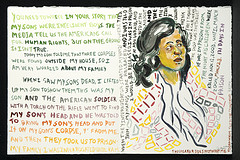
Watercolor, Heyman
For the Fringe Festival in September I’m thinking of casting small Abu Ghraib torture figures in soap for an installation…you can’t clean yourself with it…or of it
Where did you go to school?
When I graduated from Dartmouth 20 years ago. I was a liberal arts major with 9 studio courses…I made a proposal to go abroad and interview people and paint them. I wanted to do WW 2 people including Jews and especially people who were hidden. I went and interviewed people but I didn’t do the paintings.
So I’m thinking OMG I did this 20 years ago. I was 23 years old then.
Those stories were unbelievable. People – Jews – leaving a town who put their father in the hospital and then left. Or Jews who enrolled their kids in a Catholic school to hide them but the school was in cahoots with the Germans and secretly sending Jewish kids away to the camps…one family’s kids got out but not another’s.
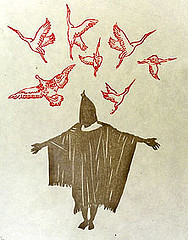
Print from Heyman’s Fleisher Challenge show in 2005
How do you paint that?
So you’ve been political and interested in this subject for years. Maybe it’s in your blood?
…My brother is a union guy…he helped Yale workers unionize.
How do you feel about doing this political work?
Where are the artists doing anti-war art?
Yes, where are they?
Well that’s my problem. Part of your job as an artist is to be a witness for your times. I feel a huge responsibility to get the story out.


